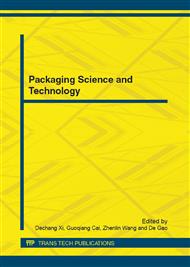p.385
p.389
p.393
p.397
p.401
p.406
p.411
p.416
p.423
Preparation and Static Cushioning Property of Foaming Packaging Material with Hemp Haulm
Abstract:
Hemp haulm is processing residues extracted after the hemp fiber, with wide raw material sources, cheap price, light quality, good fiber shapes, good toughness, high strength and good buffer performance. In order to develop the application field of hemp stalk processing residues, cushioning packaging materials were prepared using hemp haulm as raw material with the hybrid inorganic foaming agent and corn starch adhesive by microwave foaming method. The properties including density, foam distribution and static compressive properties of this material were analyzed. The experimental results indicated that the density of hemp haulm foaming cushioning packaging materials was 0.235-0.339g/cm3, cell numbers were 14-25.5/cm2, and rebound rate was 62.2%-93.1%. The major influence factors on the properties of hemp haulm foam material were the particle size, foaming agent and adhesives, etc. Research showed while the hemp haulm diameter was small, the ratio of hemp haulm power and starch was 1:0.4 and starch with polyvinyl alcohol (PVA) was 1:0.5, the materials had good buffer performance. When the ratio of compound foaming agent(sodium bicarbonate, ammonium bicarbonate, ammonium carbonate)was 1:2:1, the material had the best cushioning properties as well as higher strength. Compared with polyethylene (EPE) and polystyrene (EPS), the hemp foam material was harder than EPS with no obvious yield point, no material collapsing and good cushioning properties. When the stress was greater than 5-15 N/cm2, the cushioning property of the hemp haulm foaming material was better than EPE, but close to EPS.
Info:
Periodical:
Pages:
401-405
Citation:
Online since:
October 2012
Authors:
Keywords:
Price:
Сopyright:
© 2012 Trans Tech Publications Ltd. All Rights Reserved
Share:
Citation:


